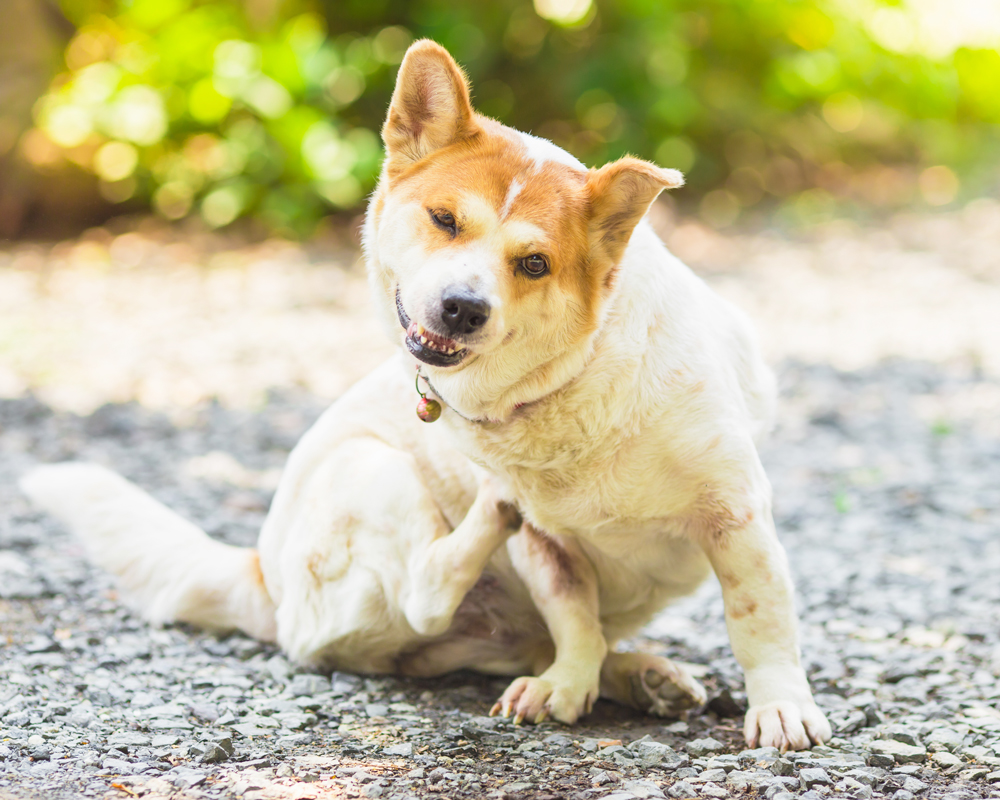- Dog CareDog LifeCommunity
- Photo Contest
Photo Contest- Giveaways
Not-So-Hot Spots
Your dog suddenly can’t seem to stop licking and worrying a spot on her body. You part the fur only to discover a moist, wet sore. What caused this and how do you fix it? Help is here!
What are hot spots?
Hot spots, which your veterinarian might call acute moist dermatitis or pyotraumatic dermatitis, are itchy, moist lesions that can seem to pop up overnight. Sometimes matted fur can obscure these infected areas of skin which your dog can’t seem to stop licking. Hot spots are classified as superficial if they only affect the outer layers of the skin and appear red and inflamed, or deep, in which case the skin is usually thickened, covered in pus, and may have lesions on the surrounding skin.
What causes hot spots?
Hot spots may seem to appear out of nowhere, but there is most often an underlying cause that’s more chronic. Any condition that can cause itching can lead to licking, rubbing, and scratching has the potential to result in a hot spot. This can include flea bites, environmental allergies, ear infections, an adverse food reaction or a bacterial overgrowth.
How do you treat hot spots?
While it is important to treat the immediate concern—your dog’s itchiness and discomfort—it’s also important for your vet to identify any underlying causes that may be present. They’ll likely use a flea comb to check your dog for these pesky parasites. Some dogs are so sensitive to flea bites that even a single flea biting your dog and jumping off can lead to full blown reaction. If a flea sensitivity is suspected, it is a good idea to keep your dog on year round flea control to prevent future reactions.
Your vet may suspect allergies based on certain clues in your dog’s history—Do they get itchy at certain times of the year, suggesting seasonal allergies? Do they flare up following exposure to certain plants? Did a change in food bring on ear scratching and paw licking? Depending on the degree of suspicion and chronicity of symptoms, recommendations may vary from trying a novel protein diet, to a trial of allergy medication, to referral to a dermatologist for allergy testing. Ear infections are also commonly linked to an underlying allergy, so these can go hand in hand with hot spots.
Since the fur is often wet and matted, usually your dog’s fur will need to be clipped. This allows the lesion to get better air circulation and encourages it to dry out. It also makes it easier for you to be able to apply topical medications, and for you to monitor the skin to make sure its healing. The skin is usually then scrubbed to remove exudate and surface bacteria. This may be uncomfortable or painful for some pets, so sometimes sedation is required to properly clip and clean.
Treatment for hot spots varies based on whether they are superficial or deep. Your vet may decide to swab the skin and look under the microscope to confirm the presence of bacteria. More mild, superficial hot spots are usually treated with a topical cream or ointment that you apply twice a day. These ointments contain an anti-inflammatory for comfort, and an antibiotic for bacteria that is present on the skin. Deeper hot spots require oral antibiotics and usually either an anti-inflammatory or an anti-itch medication.
You’ll know your dog is feeling better once the skin appears dry and returns to its normal colour. If your dog had to wear a cone or a cloud collar to prevent licking while healing, this will be a happy day for everybody in the family!
Check out Modern Dog's e-store for skin care and healing products that will help relieve your dog's hot spots.
Mammary Tumors In Dogs
Many of us know someone affected by cancer. Unfortunately, cancer in the mammary glands (similar to breast cancer in humans) can also occur in both male and female dogs. In fact, mammary tumors are the most common type of tumor seen in intact (not spayed) female dogs.
Dr. Brandan Wustefeld-Janssens, assistant professor of surgical oncology at the Texas A&M College of Veterinary Medicine & Biomedical Sciences (CVM), described some of the clinical signs of mammary tumors in dogs.
“The most common clinical finding is a firm, non-painful nodule associated with the mammary chain,” Wustefeld-Janssens said. “These nodules can range from very small to very large and may grow fast. Continued growth of bigger tumors can lead to the skin overlying the tumor to become thinned, which can cause the skin to ulcerate, bleed, and become infected.”
Tumors may also be swollen, hot, and painful to the touch.
However, only about 50 percent of mammary tumors are cancerous, with a majority of these cases being carcinoma (arising from the lining of the ducts in the mammary gland), Wustefeld-Janssens said.
Luckily, you can take preventative action to help lower your pup’s risk of developing a mammary tumor.
Dr. Heather Wilson-Robles, associate professor of oncology at the CVM, said that spaying or neutering your pet before they have their first or second reproductive season is the most effective way of preventing mammary tumors in dogs. Regular checkups at the veterinarian is also a good way to protect your pet.
“Yearly physical examinations of both male and female animals should include careful palpation of the mammary chains,” Wilson-Robles said. “Any nodule should be further investigated; often, this would include some form of biopsy. We strongly recommend against a ‘wait-and-see’ approach—any mammary tumor that is growing rapidly or is swollen, hot, or painful should be seen by a veterinarian as soon as possible.”
The chances of a tumor being cancerous increases with age, so pay special attention to any abnormalities in your older pup’s mammary glands.
If your dog does develop a tumor, surgery is the standard of care for mammary tumors. In cases where there is high risk of tumors reoccurring or spreading, radiation and chemotherapy may be used for treatment.
We can’t control the development of cancer, but we can learn the signs and symptoms of the disease and report any abnormalities to a veterinarian. Additionally, pet owners can help prevent mammary tumors by considering spaying and neutering their dog.
Dogify Your Inbox
Sign up for the FREE Modern Dog Magazine newsletter & get the best of Modern Dog delivered to your inbox.
"*" indicates required fields
By clicking the arrow, you agree to our web Terms of Use and Privacy & Cookie Policy. Easy unsubscribe links are provided in every email.

